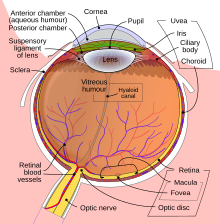| Pigment dispersion syndrome | |
|---|---|
| Other names | Pigmentary glaucoma |
 | |
| The iris(cells) plays a role in this condition | |
| Specialty | Ophthalmology |
| Medication | Latanaprost (eye drops) |
Pigment dispersion syndrome (PDS) is an eye disorder that can lead to a form of glaucoma known as pigmentary glaucoma. It takes place when pigment cells slough off from the back of the iris and float around in the aqueous humor. Over time, these pigment cells can accumulate in the anterior chamber in such a way that they begin to clog the trabecular meshwork (the major site of aqueous humour drainage), which can in turn prevent the aqueous humour from draining and therefore increases the pressure inside the eye.[1] A common finding in PDS are central, vertical corneal endothelial pigment deposits, known as Krukenberg spindle.[2] With PDS, the intraocular pressure tends to spike at times and then can return to normal. Exercise has been shown to contribute to spikes in pressure as well. When the pressure is great enough to cause damage to the optic nerve, this is called pigmentary glaucoma.[1] As with all types of glaucoma, when damage happens to the optic nerve fibers, the vision loss that occurs is irreversible and painless.
- ^ a b "Pigment-dispersion syndrome". National Institutes of Health. Retrieved October 7, 2018.
- ^ Friedman, Neil J. (2021). The Massachusetts eye and ear infirmary illustrated manual of ophthalmology (Fifth ed.). St. Louis, Missouri. ISBN 9780323613323.
{{cite book}}: CS1 maint: location missing publisher (link)